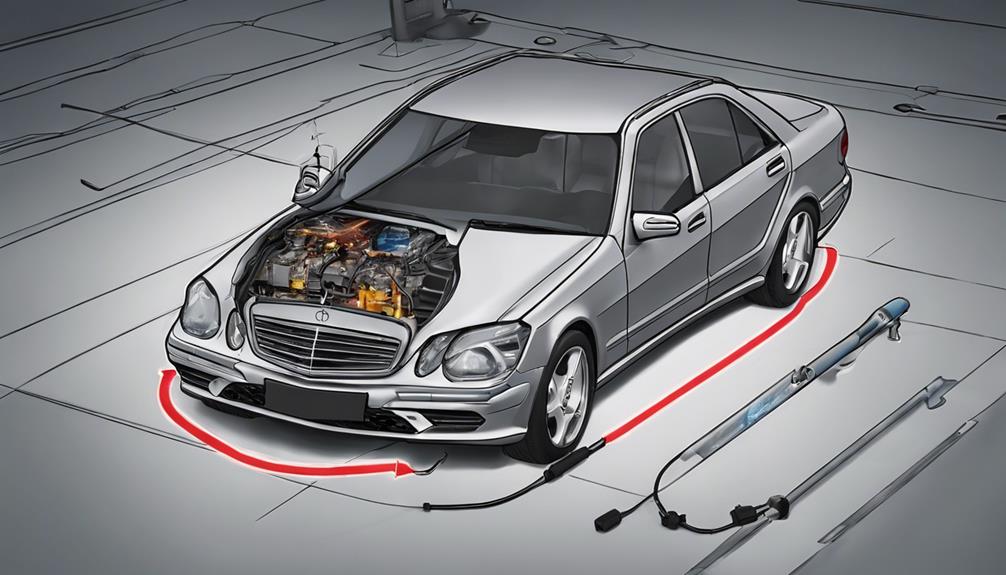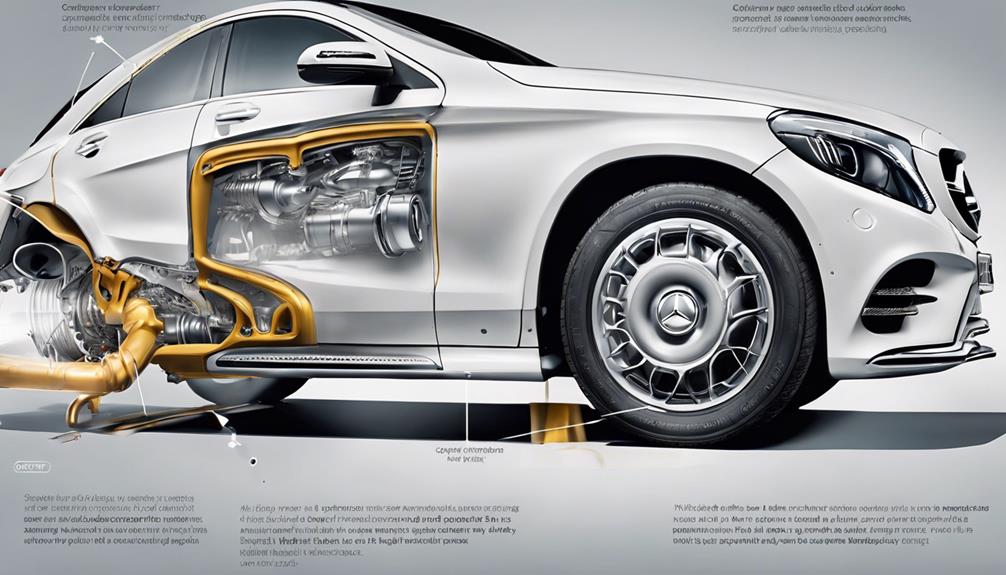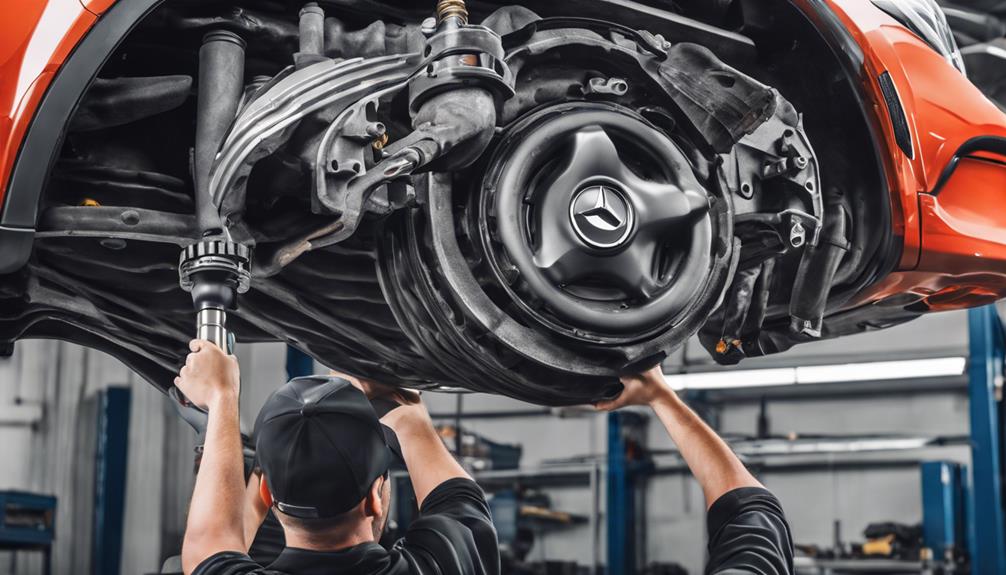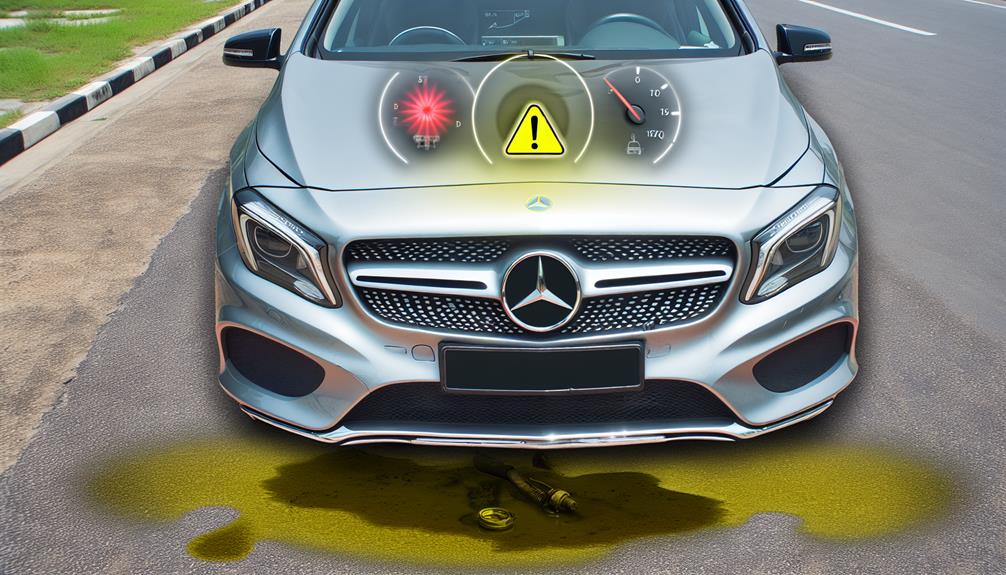If you're driving a Mercedes with AIRMATIC suspension, you might encounter common issues like leaking air struts, air compressor failures, blown fuses, and faulty level sensors, affecting your ride comfort. Be on the lookout for signs such as hissing sounds from wheels, sagging, or warning codes on the dashboard. Temporary fixes like epoxy can help, but replacing struts or addressing sensor calibration is advisable for a long-term solution. These issues could impact your vehicle's stability and performance, so staying informed about potential fixes and maintenance can keep you cruising smoothly.
Key Takeaways
- Leaking air struts are common, indicated by hissing sounds or sagging; epoxy can provide temporary fixes, but strut replacement is advisable for a long-term solution.
- Air compressor failure can result from lack of maintenance, moisture, overheating, or electrical issues; regular checks and maintenance are crucial to prevent premature failure.
- Blown fuses and relays can lead to compressor failure or improper strut inflation; prompt replacement of blown fuses and investigating recurring issues is essential.
- Faulty level sensors cause incorrect height adjustments and dashboard warning codes; timely calibration and sensor replacements are vital for accurate readings and ride comfort.
- Incorrect readings from faulty sensors can lead to a low or high vehicle stance, triggering warning lights, and causing a bumpy ride; repairing sensors ensures stability and ride comfort.
Leaking Air Struts

When dealing with leaking air struts in your Mercedes AIRMATIC system, immediate action is essential to maintain peak performance and safety. Leaking air struts are a common issue in Mercedes vehicles with AIRMATIC suspension, often caused by cracks or damage to the rubber material surrounding the struts. If you hear a hissing sound coming from your wheels or notice sagging on one side of your vehicle, it's a clear sign of a leaking air strut problem that needs attention.
While temporary fixes like epoxy can seal the leaks temporarily, it's advisable to replace the struts for a long-term solution to ensure peak performance of your Mercedes. Addressing leaking air struts promptly not only improves the overall suspension function but also enhances the safety and stability of your driving experience. Remember, maintaining your Mercedes AIRMATIC system in top condition will keep you cruising smoothly on the road without any air suspension woes.
Air Compressor Failure
So, your Mercedes AIRMATIC system's air compressor is on the fritz? Let's talk about the causes, symptoms you should keep an eye out for, and the repair and maintenance steps you can take.
When your air compressor starts acting up, it's like the diva of the AIRMATIC system throwing a tantrum – loud noises or continuous running might be its way of saying, 'Help me, I'm failing!'
Causes of Failure
If you own a Mercedes vehicle equipped with AIRMATIC suspension, understanding the reasons behind air compressor failure is essential for maintaining peak system performance. Here are some key causes of air compressor failure:
- Lack of Regular Maintenance: Neglecting routine checks and maintenance can lead to premature compressor failure.
- Excessive Moisture: Moisture entering the system can cause corrosion and damage the compressor over time.
- Overheating: Continuous strain on the compressor, like driving in demanding conditions, can cause it to overheat and fail.
- Electrical Issues: Problems with the electrical components connected to the compressor can result in failure.
- Age and Wear: As with any car part, the compressor can deteriorate over time, especially if it's subjected to heavy use without proper care.
Symptoms to Watch
To pinpoint potential air compressor failure in your Mercedes vehicle, pay attention to any unusual loud running noises coming from the compressor. This cautionary sign could indicate issues with the air compressor pump within the AIRMATIC systems.
Another indicator to watch for is if your vehicle is sagging, as this could be a result of failing air due to a malfunctioning air compressor. Check for any leaks in the air springs when the warning appears, as leaks can worsen problems.
If no leaks are found but the symptoms persist, it may be necessary to replace the air compressor to prevent further damage and restore the proper functioning of your Mercedes AIRMATIC system.
Repair and Maintenance
When encountering air compressor failure in your Mercedes AIRMATIC system, timely repair and maintenance are crucial to prevent further damage and guarantee peak performance. Here are some key points to ponder:
- Regularly inspect the air suspension compressor to catch any issues early on.
- Address any loud running noises promptly to prevent potential system failure.
- Replace a failed air compressor to avoid further damage to your AIRMATIC system.
- Timely maintenance can help uphold the top-notch performance of the AIRMATIC suspension in your Mercedes vehicle.
- Consulting a professional for repair is advisable to safeguard the proper functioning of the air compressor and the overall system.
Blown Fuses and Relays
In Mercedes AIRMATIC systems, blown fuses and malfunctioning relays can wreak havoc on the air compressor pump, leading to potentially costly repairs and system failures. Blown fuses in the air compressor pump can result in compressor failure, while malfunctioning relays may cause deflated struts as the compressor system fails to activate. On the other hand, bad relays could lead to overinflated struts, putting excess strain on the compressor. Addressing blown fuses promptly is vital to prevent repeated failures in the air compressor pump. It is essential to investigate further if a blown fuse keeps recurring to avoid potential damage to the compressor. Check out the table below for a clearer picture of how blown fuses and relays can impact your Mercedes AIRMATIC system:
| Issue | Impact |
|---|---|
| Blown Fuses | Compressor Failure |
| Malfunctioning Relays | Deflated Struts due to no activation |
| Bad Relays | Overinflated Struts causing strain |
| Repeated Failures | Costly Repairs and System Failures |
Faulty Level Sensors

When it comes to faulty level sensors in your Mercedes AIRMATIC system, the sensor calibration process is essential for accurate height readings. Understanding common sensor replacements can help you tackle issues efficiently and get your ride back on track.
Sensor Calibration Process
To ensure your Mercedes AIRMATIC system functions at its best, precise calibration of the level sensors is essential for maintaining accurate ride height readings. When dealing with sensor calibration, keep these key points in mind:
- Faulty level sensors can lead to incorrect height adjustments.
- Warning codes may appear on the dashboard when sensors malfunction.
- During diagnosing, don't forget to inspect the linkages and electrical components.
- Calibration of sensors is crucial for accurate readings and proper ride height.
- Timely attention to sensor calibration issues can prevent further suspension damage and uphold peak performance.
Common Sensor Replacements
If your Mercedes AIRMATIC system is experiencing issues with faulty level sensors, prompt sensor replacements are vital to maintaining top performance and ride comfort. Faulty level sensors can disrupt the air suspension system, leading to incorrect vehicle height adjustments and triggering warning lights on your dashboard.
These malfunctions not only impact the suspension but can also affect your overall ride quality. To address this, a thorough check of the linkage and electrical components related to the level sensors is essential for proper diagnosis and suspension repair.
Timely replacement of these sensors is key to preventing further damage to your Mercedes AIRMATIC system and ensuring a smooth and enjoyable driving experience.
Impact on Ride Comfort
For peak ride comfort and stability with your Mercedes AIRMATIC system, ensuring the level sensors are functioning correctly is essential. Faulty level sensors in the AIRMATIC system can lead to an uneven adjustment of the vehicle's height, impacting ride comfort.
Here are some key points to keep in mind:
- Incorrect readings from malfunctioning level sensors can cause the vehicle to sit too low or too high, affecting the overall driving experience.
- Unreliable level sensors may trigger warning lights on the dashboard, indicating a potential issue with the AIRMATIC suspension.
- The misalignment caused by faulty level sensors can result in a bumpy and unstable ride, compromising the comfort and handling of the vehicle.
- Addressing and repairing faulty level sensors is vital for maintaining the excellent ride comfort and stability provided by the Mercedes AIRMATIC suspension system.
Vehicle Sagging and Hissing

When your Mercedes AIRMATIC suspension system shows vehicle sagging and hissing, it's important to address these signs promptly to prevent further issues. Vehicle sagging on one side often signals a failing air strut, while hissing sounds near the wheel indicate air leaks in the system, causing pressure loss and eventual sagging. While temporary fixes like using epoxy can seal minor leaks in the air struts, for a long-term solution, replacing the damaged struts is recommended. Epoxy might offer a short-term remedy, but it's not a permanent fix for the underlying problem. Regularly inspecting the air struts for cracks, holes, or significant rubber damage is vital to prevent vehicle sagging and ensure proper suspension function.
| Common Signs | Recommended Actions |
|---|---|
| Vehicle sagging | Check for failing air struts and replace if necessary |
| Hissing sounds | Investigate for air leaks and consider long-term strut replacement |
| Temporary fixes | Use epoxy as a short-term solution, but plan for permanent repairs |
| Inspection | Regularly check air struts for damage to prevent sagging |
| Long-term solution | Replace damaged air struts for lasting suspension health |
Temporary Epoxy Fixes
In addressing temporary epoxy fixes for leaking air struts in your Mercedes AIRMATIC suspension system, consider the quick and cost-effective solution they offer before pursuing a permanent repair option. Temporary epoxy fixes can be a handy short-term solution to seal leaks in your air struts, preventing vehicle sagging and restoring proper functionality to your AIRMATIC suspension system. Here are some key points to keep in mind:
- Epoxy can effectively seal leaks caused by cracks or damage in the rubber material of the air struts.
- While epoxy provides a temporary fix, it's advisable to replace the failing air struts for a long-lasting solution.
- Using epoxy can help you avoid costly repairs in the short term and keep your suspension system working.
Temporary epoxy fixes offer a quick way to address leaking air struts, saving you time and money. Consider epoxy as a cost-effective measure to tackle air strut leaks before exploring permanent repair options.
Conversion to Coil Springs

Consider upgrading your Mercedes AIRMATIC suspension system to coil springs through an air suspension conversion kit for improved durability and reduced maintenance costs. Coil springs offer a long-lasting solution, providing a dependable answer to typical Mercedes AIRMATIC problems while saving you money on expensive repairs in the future. By making the change, you can enjoy a more robust suspension system that requires less maintenance over time. Conversion kits, like those available from specialists such as Strutmasters, offer the opportunity to smoothly shift from AIRMATIC to coil spring suspension, ensuring a smoother ride and fewer headaches in the future.
| Benefits of Conversion to Coil Springs | |
|---|---|
| Reduced Maintenance Costs | Save Money |
| Increased Durability | Reliable Solution |
| Long-Term Solution for Common Issues |
Frequently Asked Questions
What Is the Problem With the Mercedes Airmatic Suspension?
Experiencing issues with your Mercedes AIRMATIC suspension? Symptoms like a rough ride or leaning vehicle could indicate problems. Get a professional evaluation to tackle the root cause promptly, ensuring safety while driving.
What Are the Symptoms of Airmatic Compressor Failure?
When your airmatic compressor fails, you might notice the system struggling to maintain your ride height steady. This issue can lead to dashboard warnings and safe mode activation. Checking for air spring damage and leaks is essential.
Can You Drive With Airmatic Malfunction?
You shouldn't drive with a malfunctioning Airmatic system. Doing so could lead to an uncomfortable ride, potential safety hazards, and further damage. It's best to address Airmatic issues promptly to guarantee a smooth and safe driving experience.
What Is the Major Problem With Air Suspension?
When it comes to air suspension, the major headache is air leaks causing sagging and failure. Compressor issues also haunt these systems, hindering proper air generation. Don't forget about relays, fuses, and sensors—misbehaving elements that can drive you crazy!
Conclusion
So there you have it – common Mercedes Airmatic issues and problems that can be a real headache for owners. From leaking air struts to faulty level sensors, these issues can cause your vehicle to sag and hiss like a deflating balloon.
But fear not, there are temporary epoxy fixes available and even the option to convert to coil springs. Stay on top of maintenance and keep an eye out for these issues to guarantee a smooth ride in your Mercedes.









